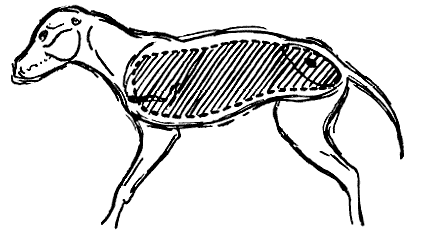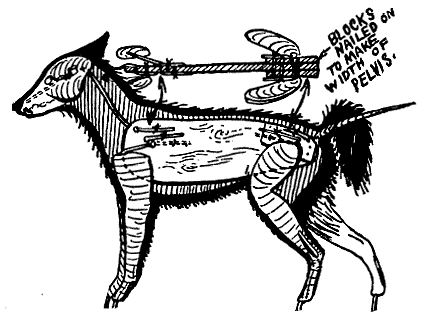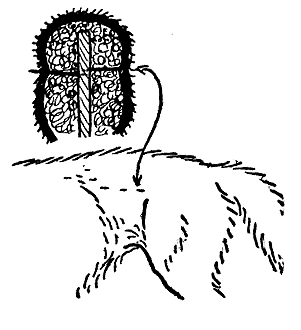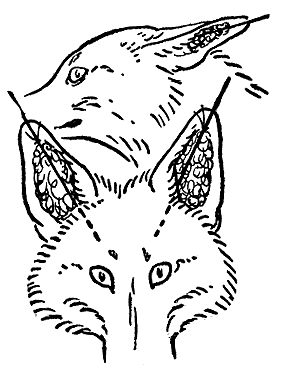 Taxidermy supplies and tips
Taxidermy supplies and tipsLearning taxidermy
History of taxidermy
Bird taxidermy
Coyote taxidermy
Skinning coyote
Coyote mount<
Deer taxidermy
Fish taxidermy
Muskrat taxidermy
Squirrel taxidermy
Taxidermy panels and shields
Making animal fur rugs
Taxidermist hunting
Taxidermy mounting kits
Other resources
Coyote mount
Wire the leg bones same as in a small mammal, using soft iron rod of sufficient size to support the specimen firmly. In our coyote a
quarter-inch rod will be required. In a bobcat a three-sixteenths-inch rod will be large enough to support sturdily.
Bend the leg rods to fit the joints in position desired. Cut the rods of a length so that six or eight inches will protrude from the feet and eight or ten inches will remain free above to anchor to the body core. Bind the rods to the leg-bones with strong, light cord, doing the firmest wrapping near the joints.
Working over the body outline, cut a one-inch-thick board core that will set well within the outline. (See Fig. 41.)

Cut a neck-rod of same size as for legs, having it twice as long as neck and head. Near one end of the neck-rod bend a jog to hold well when set with plaster of paris and chopped fiber into the brain cavity of the cleaned skull.
Wrap the leg muscles upon the bones same as in a small specimen, except pull the excelsior rather smooth for the purpose instead of rolling it in the palms. Make the Achilles tendon in same way and leave back of thigh off to be stuff ed.
When the plaster to hold neck-rod in head is set, anchor the skull by the rod to the coreboard in proper relation to the body. To do this, run the rod through a hole drilled through the board, clinch rod down forward and back with a hammer on anvil or vise, and fasten
with staples, or drill a small hole through coreboard each side of rod and tie the rod down with a strong loop of wire twisted down with the pliers.
Wrap the skull muscles on with excelsior rolled in palms of hands. Wrap a tail of pulled excelsior laid straight along a wire much smaller than is used in legs.

Drill the center-board for legs and tail as shown in Fig. 42, which shows general assemibling details. When the legs, head, and tail are finished, push the head and body-core into place in the skin, shove in the legs and tail, and wire the legs and tail fast in the center-
board same as head was fastened.
The remainder of the mounting is accomplished in exactly the same way as the filling and finishing of a small mammal specimen, i.e., by stuffing the neck, body, and back of thighs and finishing the face and feet with a batch of papier-mache compo. No. 2. If the
mouth is to be open, follow directions given for finishing an entire rug-head.

To hold in the hollow of the flanks, cut several short, strong pieces of wire, sharpen Fig. 43. them to cutting points, push them through the skin along line of hollow in f ront of hip, drive them firmly into the core-board, and then, with cutting pliers clinch their ends down to hold the skin in and cut off surplus wire, picking the fur out well to cover them. (See Fig. 43.)
To support the compo.-filled ears until set and dry, drive a sharpened wire into the head, through hollow of ear. Point the wire in direction ear is to lay or stand and between ear and wire lay a loose, flat wad of cotton or tow. With a furrier's needle and thread take a narrow loop through center of ear near tip and tie lightly around wire to hold until dry. When dry remove the thread with scissors and the wires by a slight twist with pliers.
Fig. 44.

Mammals of the sizes named may be mounted so skillfully by this method that they cannot be told from mannikin specimens.
Specimens of this size need not be entirely mounted at one sitting. Prepare the skin, wire and wrap the legs and head, and make the
center-board in one day, assemble the specimen and place the body filling the next day, and make the feet, mount the specimen, and finish the, head the third day.

